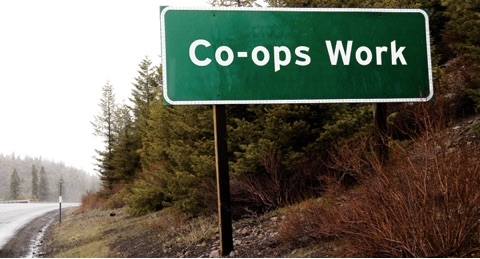Resilience: Co-ops 101 - An Introduction to Cooperatives 1/3

Corporate capitalism has failed western societies. In the western world, inequality is at its highest on record, the environment is threatened, and local communities have become corporate dependencies. Presently, many businesses in a community are not local, but are franchises of a national or multinational corporation that pays its workers as little as possible, ruins the environment, and sends the profits to investors far away. Many consumers are left isolated individually with no bargaining power.
In order to grow resilient local economies, communities will have to develop local businesses and local organizations to break the stranglehold that multinational corporations have on them.
The cooperative is a form of organization for business or for consumers that works for the betterment of the local community - its people, environment, and its economy. This is the first in a three-part series on co-ops. More below.
Might as well play the good old stuff
Set out below is an overview of cooperatives, summarized from a 1997 U.S. Department of Agriculture Information Report.* Folks, this really is Co-ops 101; it's a basic, simple introduction. Following this series, we'll get into the details of various co-ops. I should emphasize their importance: co-ops are the primary vehicle for weaning a local community off of perfidious corporations. The only legal forms of conducting in towns should be single-owner, partnership, and co-op. The corporation has no place in the human future: it is a sociopathic invention by pathologically greedy people to rob society blind.

Introduction
A cooperative is a business owned and democratically controlled by the people who use its services and whose benefits are derived and distributed equitably on the basis of use. The user-owners are called members. They benefit in two ways from the cooperative, in proportion to the use they make of it.
First, the more they use the cooperative, the more service they receive.
Second, earnings are allocated to members based on the amount of business they do with the cooperative.
They are usually incorporated under state law by filing articles of incorporation, granting them the right to do business. The organizers draw up bylaws and other necessary legal papers. Members elect a board of directors. The board sets policy and hires a manager to run the day-to-day operations.
Chapter 1: A Historical Perspective
For the history of cooperatives in the U.S. please refer to the report. It is a good read and it is good to see the foundational role that co-ops played in so many areas of society - rural development is one example.
The corporatist media pretend that "heroic" individuals working for their private gain built our societies.
The old "rugged individual" con. That is bullshit.
The heroic individuals all co-operated together to build farms, villages, community organizations, and the public good so that individuals could work out their own economic salvation within the matrix of a civil society. The greedy ones then moved in to steal as much for themselves as they could and then lie about it for the rest of their scrooged lives.

Chapter 2: Cooperative Principles and Practices
These principles are more than just good practices, policies or common sense.
They distinguish a cooperative from other kinds of business - such as the corporation.
They are also recognized in state and federal statutes and regulations as criteria for a business to qualify as a cooperative.
The User-Benefits Principle
Members unite in a cooperative to get services otherwise not available, to get quality supplies at the right time, to have access to markets or for other mutually beneficial reasons.
Acting together gives members the advantage of economies of size and bargaining power.
They benefit from having these services available, in proportion to the use they make of them.
Members also benefit by sharing the earnings on business conducted on a cooperative basis.
When cooperatives generate margins from efficient operations and add value to products, these earnings are returned to members in proportion to their use of the cooperative.
Without the cooperative, these funds would go to other middlemen or processors.
The User-Owner Principle
The people who use a cooperative own it. As they own the assets, the members have the obligation to provide financing in accordance with use to keep the cooperative in business and permit it to grow. Accumulating adequate equity is a major challenge facing many cooperatives. How this task is accomplished is discussed later.
The User-Control Principle
As owners, a cooperative’s members control its activities.
This control is exercised through voting at annual and other membership meetings, and indirectly through those members elected to the board of directors.
Members, in most instances, have one vote regardless of the amount of equity they own or how much they patronize the organization.

Chapter 3: Cooperatives in the Community
Financial Cooperatives
The largest single segment of the cooperative industry is credit unions.
Building on their base of member savings and consumer loans and home mortgages, credit unions also offer additional services to their members including credit cards, automated teller machines, tax-deferred retirement accounts and certificates of deposit.
Consumer Service Cooperatives
Cooperative Housing
America has about 1 million units of cooperative housing, nearly 600,000 of them in New York City (1997 numbers). New units are being developed in many other areas including senior citizen communities, trailer parks, low-income complexes, and student housing near college campuses.
http://www.coophousingsk.ca/
Cooperative Healthcare Providers
Millions of Americans receive basic medical care through cooperatively organized health care providers. Health maintenance organizations (HMO’s) serve more than 1 million people coast-to-coast and will likely be an increasingly important part of the health care system in the years ahead. In several major cities- Seattle, Minneapolis, Memphis, Sacramento, Salt Lake City and Detroit--companies have formed cooperative health alliances to purchase health care for their employees.
Child care cooperatives are meeting the needs of families where the parent(s) are employed and want affordable supportive care for their young children while working. These centers can be organized by parents on their own, by a single employer, or by a consortium of businesses providing a single center for the group.
Business Cooperatives
More than 15,000 independent grocery stores rely on cooperative grocery wholesalers for identity, brand names, and buying power they need to compete with the chains and the discounters. Members also receive training and financing. Several cooperative grocery wholesalers are multi-billion dollar firms rivaling the largest farmer cooperatives in sales and assets.
Cooperatively owned hardware wholesalers supply virtually all of the independent hardware stores in the United States. As huge warehouse chains spread across the nation, the independents are relying more and more on Cotter and Company (True Value), Ace Hardware and other cooperatives for products, promotions and education to remain viable businesses.
Cooperatives are leaders in other major industries including outdoor goods and services (Recreational Equipment Inc.), lodging (Best Western), carpeting (Carpet One), insurance, natural foods, hospital and pharmacy supply, and collegiate bookstores.
Farmer Cooperatives
Marketing cooperatives handle, process and sell cotton, dairy products, fruits and vegetables, grains and oilseeds, livestock and poultry, nuts, rice, sugar and other agricultural commodities.
Farm supply cooperatives provide farm chemicals, feed, fertilizer, petroleum products, seed and other input items to producers.
Farm service cooperatives operate cotton gins, provide trucking and artificial insemination services and store and dry products.
Rural Co-operatives
Another important cooperative activity in rural areas is furnishing electric power.
Nearly 1,000 rural electric cooperatives operate more than half of the electrical lines in America, providing electricity to more than 25 million people in 46 States. Sixty of these are called generation and transmission cooperatives (G&Ts) because they generate and transmit electricity to meet the power needs of the other cooperatives that distribute electricity to the people.
Telecommunications services to rural areas are also provided by cooperatives.
The National Rural Telecommunications Cooperative, owned by almost 800 rural electric and telephone systems, makes satellite television available to rural areas not served by cable companies. Cooperatives may be the on-ramp for rural residents wishing to travel the information highway.

That's where we leave off this time. The next chapter, number 4, is about the benefits of co-operatives. More in Part 2 soon.
As always, I look forward to your comments. I would love to hear your stories of how co-ops changed your local community.
Peace be with us, if we use the co-operative instead of the corporation,
gerrit
* This summary was taken from Co-ops 101: An Introduction to Cooperatives. It was written Donald A. Frederick, Program Leader, Law, Policy & Governance, Cooperative Resources Management Division, Rural Business-Cooperative Service, U.S. Department of Agriculture. It is called Cooperative Information Report 55 (April 1997, Slightly revised June 1997.)


Comments
Co-op is a complex term, like internal combustion engine (ICE)
And internal combustion engines, like co-ops, do many different things, for different reasons.
The first thing I thought when i saw/read this is: he's lumping all co-ops together. Are planes, trains, boats, automobiles -- all in the same category? Yeah, the all use ICE. But if you want to float, or fly, you would want to choose the transport with an ICE that is appropriate.
Those hardware stores -- those are all producer co-ops. So they are operated for the benefit of those producers. Not citizens, or consumers, or the environment, or society.
I am 100% behind co-ops, worker co-ops. They float. Producer co-ops? They keep producers afloat.
And I am 100% behind any effort that brings more visibility to co-ops, such as this article.
The main point, to me, concerning co-ops is that they are democratically controlled! The modern corporation and the vast majorities of 'jobs' are top-down, shut-up-follow-orders type of organizations that leave people, as Marx would put it, alienated - from reality, the product, their job, their community, society, and their democracy.
That the co-op is democratically controlled is important. That is why I believe co-ops are so much more prevalent outside the USA, because inside the USA there is little to no democracy. ;->
See Richard Wolff's http://www.democracyatwork.info and Gar Alperovitz's http://democracycollaborative.org for more info.
See also Cultivate.Coop. Cultivate.Coop is a library of information about cooperatives. [Gee, there's a whole first-level domain "coop" for co-ops that only twelve people in the USA even knew about ... a whole world beyond dot com America ...]
Keep up the good fight, Gerrit!
Good morning, GreyWolf, and big TY for this. Indeed, worker
co-ops is what I'll be driving towards. I hope to post a series of stuff about worker co-ops. As you saw, this series is just a basic intro to the concepts of co-ops. I hope to get Part 2 out this morning.
I'm so glad you're here to help give more precision to terms and concepts and to help flesh out ideas and how-to's. Have a great day, my friend,
Resilience: practical action to improve things we can control.
3D+: developing language for postmodern spirituality.